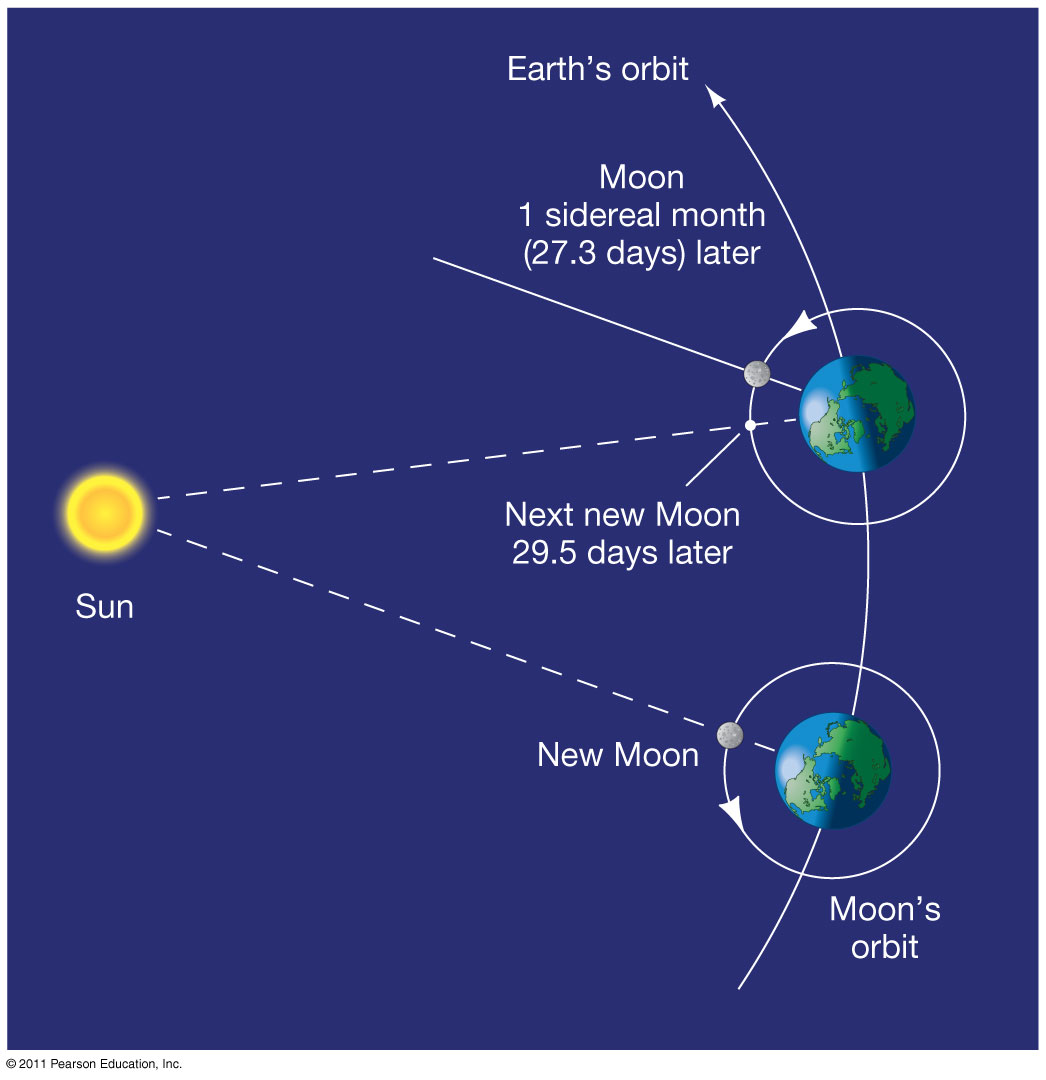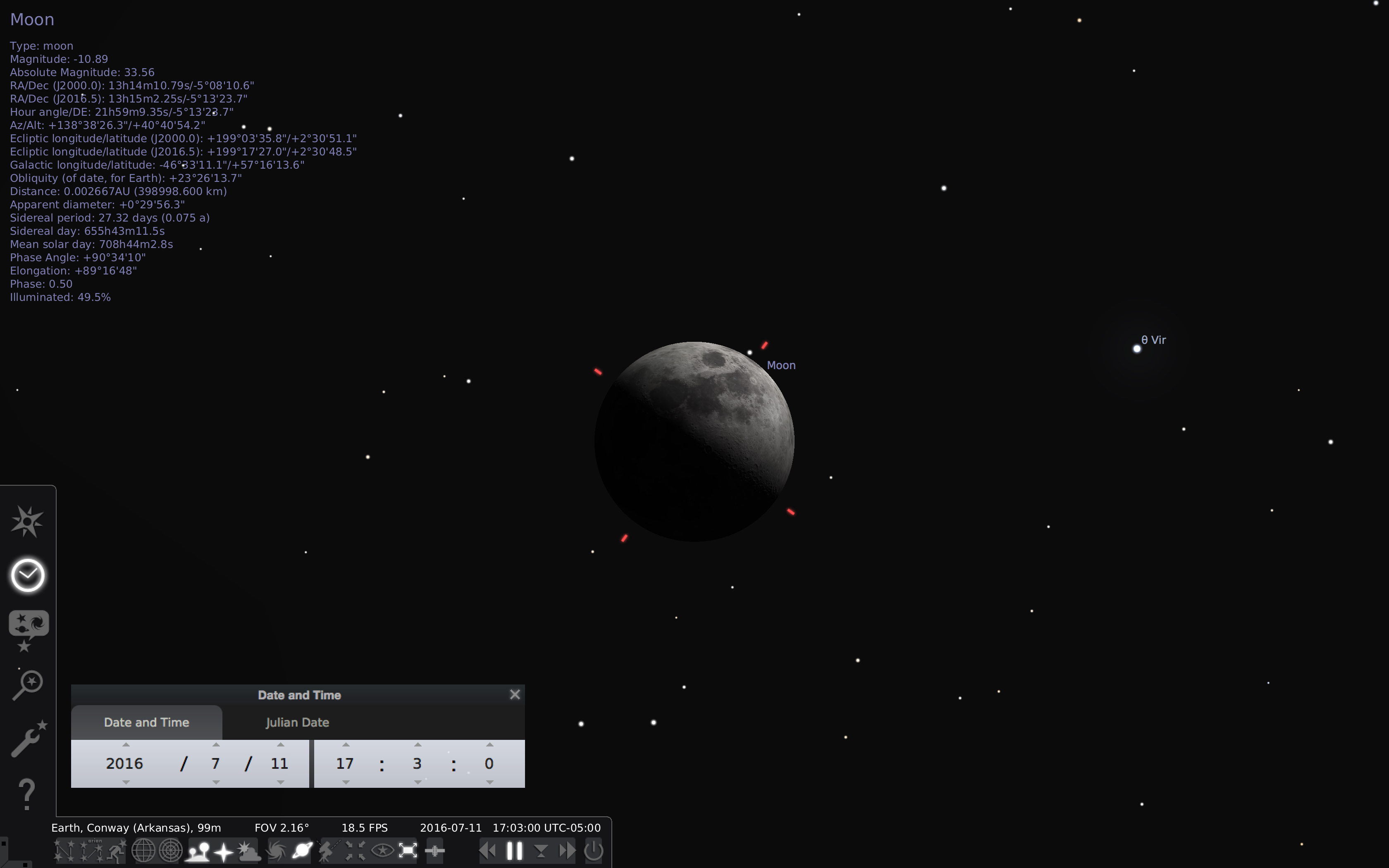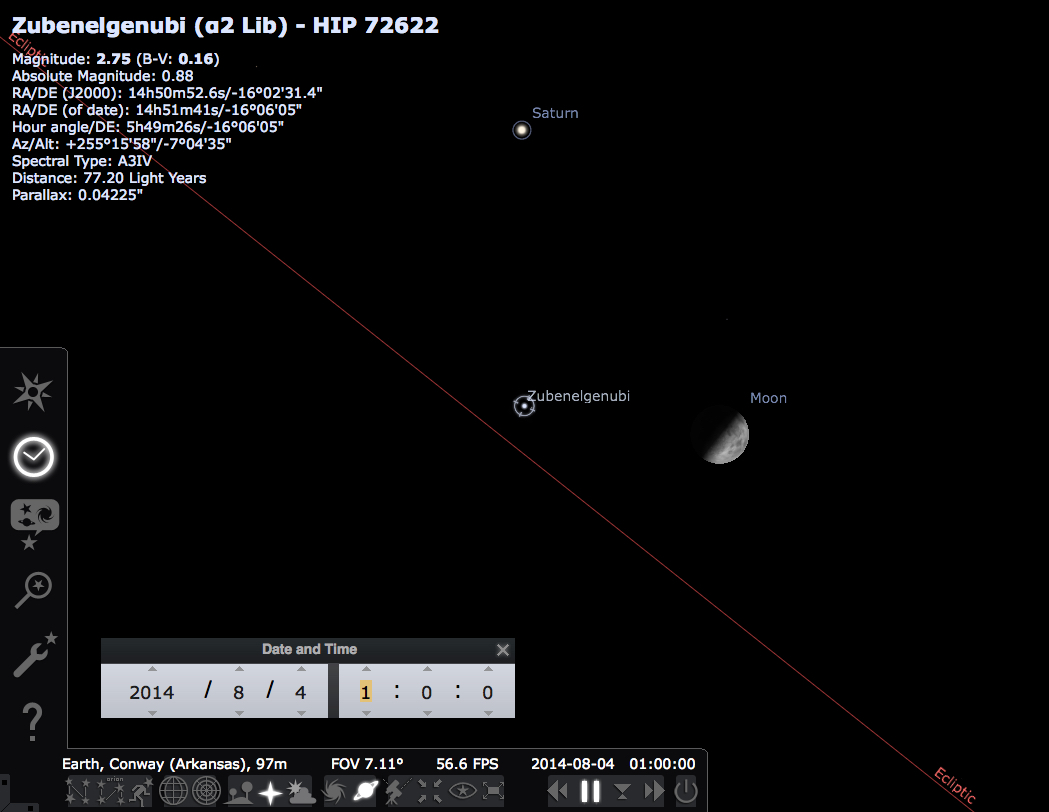Introduction
Everyone knows how long a month is...it's 30 days. Or is it 31? Maybe 28, or even, on occasion, 29? A calendar month can ultimately trace its origin back to the idea of marking time by the cyclic phases of the moon, but there is currently no correlation between any specific day or date and any specific lunar phase. You cannot say that the moon will always be full on January first, and you cannot say that January ends and February begins precisely at the next full moon.
As we saw previously, the length of a day depends on how you measure it. It should not surprise us, then, that the same thing is true of the moon. We have the obvious cue of the phase: one month is how long it takes for the moon to complete one cycle of phases, from full moon to full moon (or new to new, or whatever phase you choose). This is a synodic month. Like the measure of a sidereal day, the measurement of the sidereal month references the motion of the moon to a stationary star. We will use the Stellarium program to examine and compare both of these ideas.

Objectives
- Distinguish between synodic and sidereal period of revolution
- Measure the synodic period of the moon
- Measure the sidereal period of the moon
- Practice locating and referencing objects using celestial coordinates
Synodic Month
- Open Stellarium: Make sure your location is correctly set for Conway, AR. If Conway is not the default location, you may want to make it the default location.
- Find the moon: Use the Find Object window to locate the moon, and then click Center on Selected Object (keystroke = space bar). To zoom in on the moon and see its phase, use the forward-slash keystroke (back-slash zooms you back out). Toggle off both the atmosphere and the horizon to better see the phase information.

- Set the date: For today, 07/11/16 (time 17:00:00), and adjust the time (increment the minutes) until you see the moon in its first quarter phase (0.50). Exactly half of the moon should be illuminated, and the terminator should be straight (as opposed to curved). To keep this simple, adjust time by hour and minute increments. Do not attempt to fine-tune this to the level of seconds.
- Advance the date: Increase by exactly one calendar month, then adjust the day forwards or backwards until you have the moon in the same phase (0.50, or 50.0%) again. Fine-tune the phase by adjusting time in hour and minute increments (again, no seconds). Record the date and time of the first quarter moon.
- Calculate the month: The elapsed time from first quarter to first quarter phase is one synodic month. You may use this online unit conversion program to determine the length of time between your observations. This will give you a time in hours. Convert this value to days by dividing the hours by 24.
- Complete the observations: Reproduce the table below in your lab notebook, completing the observations. Determine the synodic month for each of the intervals over the course of a year:
Date |
Time |
Synodic Month (days) |
| 07/11/16 |
17:03:00 |
|
| |
|
| 10/08/16 |
|
|
| |
|
| 01/05/17 |
|
|
| |
|
| 04/03/17 |
|
|
| |
|
Average Synodic Month (days) |
|
|
|
Average Synodic Month
- Calculate the synodic month: Average the length of a synodic month from your data. Compare this to the accepted value of 29.5 days by calculating the percent error in your value:

- Why is your percent error not exactly zero? Discuss/explain why your results do not match the known value exactly.
Sidereal Month
To measure the lunar sidereal month, we need to compare the position of the moon with the position of a fixed star. The easiest way to do this is to select a star that lies on or near the ecliptic, since the moon cannot stray far from this line. In one sidereal month, the moon will be in the same position with respect to the star. We will select an appropriate star, then adjust the date and time until the moon matches the RA coordinate of the chosen star.
- Increase your field of view: Zoom out (\) for a greater field of view. It will also be helpful to toggle on the equatorial grid (keystroke = e) and the ecliptic (keystroke = comma).
- Set the date and time: Go to 07/13/16 at 20:00, and center on the moon. You should notice that there is a star (Zubenelgenubi) almost exactly on the ecliptic, close to Mars and Spica.

- Find Zubenelgenubi: Click on the star and record its J2000 RA coordinate. Remember that the RA/DE coordinates of the stars do not change. Note that you only need the RA coordinate, however.
- Match the RA: Click on the moon again, and adjust the time until its J2000 RA matches that of Zubenelgenubi. You must adjust both minutes and seconds to fine-tune the alignment. (Note that the DE of the moon will never precisely match the DE of the star.)
- Record and advance: Note the date and time, then advance the date by exactly one calendar month. As in the previous exercise, adjust the day and then the time until the moon has precisely the same RA alignment with Zubenelgenubi. By adjusting the time down to the second, you should be able to match the RA exactly.
- Observe the moon phase: Zoom in on the moon and accurately sketch or describe its phase. Note that the new moon is 0.00, and a full moon has phase 1.00. You should distinguish between a waxing and waning moon. For example, a phase = 0.50 may mean either a (waxing) first or (waning) third quarter moon.
- Complete the observations: Reproduce the table below in your lab notebook, completing the observations. Determine the length of the sidereal month for each of the intervals over the course of the year:
Date |
Time |
Lunar Phase |
Sidereal Month (days) |
| 07/13/16 |
20:08:59 |
|
|
| |
|
|
| 10/03/16 |
|
|
|
| |
|
|
| 01/20/17 |
|
|
|
| |
|
|
| 04/12/17 |
|
|
|
| |
|
|
Average Sidereal Month (days) |
|
Average Sidereal Month
- Calculate the sidereal month: Using the same technique as before, calculate the elapsed time between observations. This is the sidereal month. Use this online conversion tool. Divide the total number of hours (with decimal) by 24 to get the sidereal month in days (with decimal).
- Calculate the percent error: Find the average length of the sidereal month. Compare it to the accepted value of 27.3 days by calculating the percent error in your average sidereal month:

- Why are the phases different? Explain why the phase of the moon is different for each of your sidereal observations.
- Why are the months different? Use a sketch to clearly show why the synodic and sidereal periods of the moon are different. You should be able to see from your sketch why the sidereal month is shorter than the synodic.
|



